Spinone Italiano
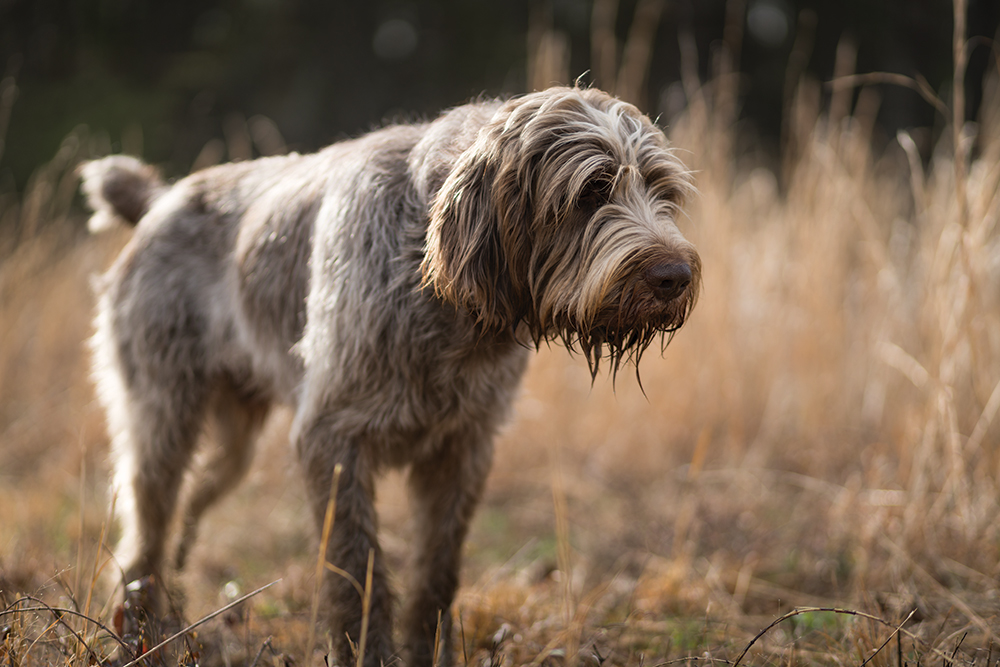
The Ducal Palace in Mantua, Italy, has a room known as the “bridal chamber,” with elaborate frescoes painted by court artist Andrea Mantegna between 1465 and 1474. The west wall painting, Meeting Scene, depicts Marquis Ludovico III Gonzaga dressed up for an official meeting with his son, the cardinal. A large, light-colored dog with rough, wavy hair is curled up at the marquis’s feet. The north wall’s Court Scene shows Ludovico hanging out with his wife and courtiers. The same big dog is resting under the marquis’s chair. Many people believe that dog, Rubino, who was Ludovico’s favorite, was an early Spinone.
As with so many breeds, the Spinone’s history is peppered with arguable claims and conflicting reports. What is agreed, however, is that the modern Spinone came from rugged lines developed in the 1800s in the mountainous regions of northern Italy. They are deep-chested endurance trotters with a harsh coat and well-arched, thickly padded front feet. The Spinone broken topline and balanced angulation front to rear make them flexible and sure-footed, with an economical gait. These traits, along with excellent game-finding skills, help reduce the amount of ground that has to be covered in tough terrain, sparing both the hunters and the dogs.

Like many owners of hard-driving, sexy-pointing German shorthairs, I had been skeptical of Spinone field prowess. The ones I’d gunned over at training clinics and hunt tests would find their birds and do their chores diligently, but working planted chukars has a practiced component that can mask—or mimic —true hunting skills. Added to that, Spinoni just looked too lovable to be convincing. With the exception of a few snappy points, most of those big, shaggy dogs looked like they would be just as happy fetching slippers or smiling into a cookie jar as hunting birds.
It took just one hunt with Ludo to change my mind. His solid neck, powerful shoulders, and athletic body profile support an extended stride and loose gait, the rustic Spinone style. Scenting into the north wind on a chilly November morning last fall, Ludo set a consistent pace quartering through stands of poplar and dogwood. He didn’t tear through the cover, but worked the ground scent and air movement with the kind of bird-dog intelligence that can’t be taught. Either it’s in the dog’s genetic package, or it’s not.
Easily visible in the thick woods, 95-pound Ludo kept a 30- to 50-yard range from the guns. He crisscrossed in front of us as we climbed up a small slope to a reliably birdy section of mixed brush, apple trees, and conifers. Ludo circled one of the bare apples cautiously, practically rubbing his nose through the soft browned fruit on the ground. His tail swooped gently left to right.
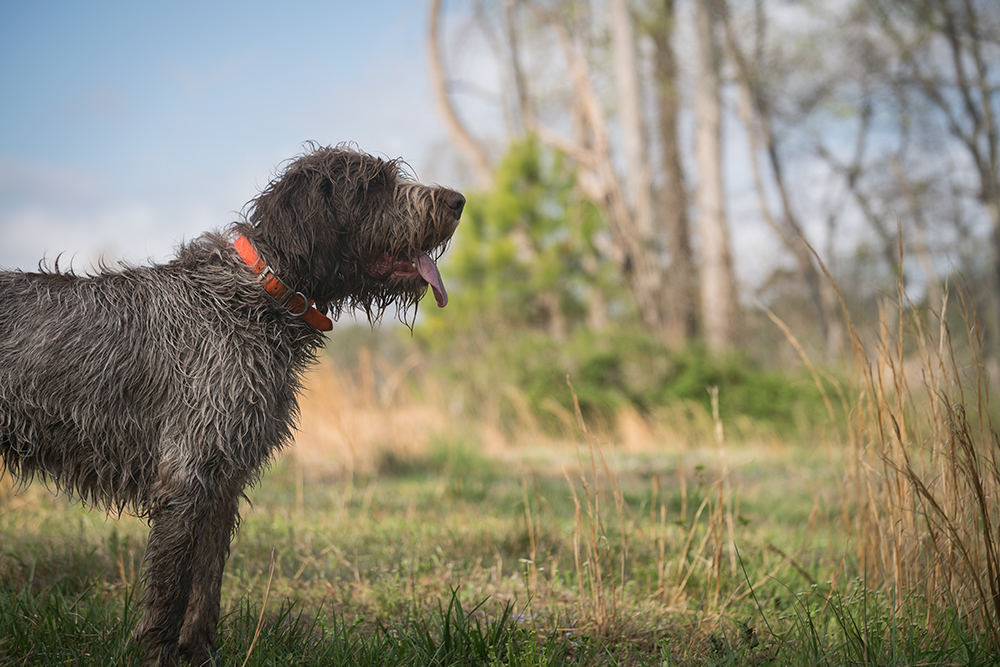
Soon enough, he went rigid, staring straight ahead, tail level at 3:00 on the dial. He was unlike the angled-down-and-forward silhouette of many pointers—you could draw a line from the top of his head to touch the top of his hindquarters, his back lower in between.
Ludo’s co-owner Karen Beyer and I cautiously moved forward, splitting up to have a shot on either side of the tree. We inched through thorny whips, barrels up, straining to see movement on the ground. Anyone who’s hunted ruffed grouse knows the adrenaline of waiting for the stealthy bird to flush. And anyone who’s hunted ruffed grouse knows that, likely as not, the bird will blow out with a minimum of 50 yards of impenetrable brush between it and the guns. That was exactly what happened. Ludo didn’t seem to mind, though. With a glance over to us and one sweep of his tail, he went back to work.
Ludo’s story begins with breeder and trainer Carolyn Fry of Bedeslea Spinoni in East Devon, England. For 30 years, Carolyn has focused on producing the “whole Spinone,” with breed traits as important as hunting skills. Ludo came from an imported Italian brown roan male, Ludstar Callisto, and Carolyn’s champion white/orange female Bedeslea Brindisi. (But no, Ludo’s name doesn’t refer to Ludovico, that Spinone-loving marquis.)
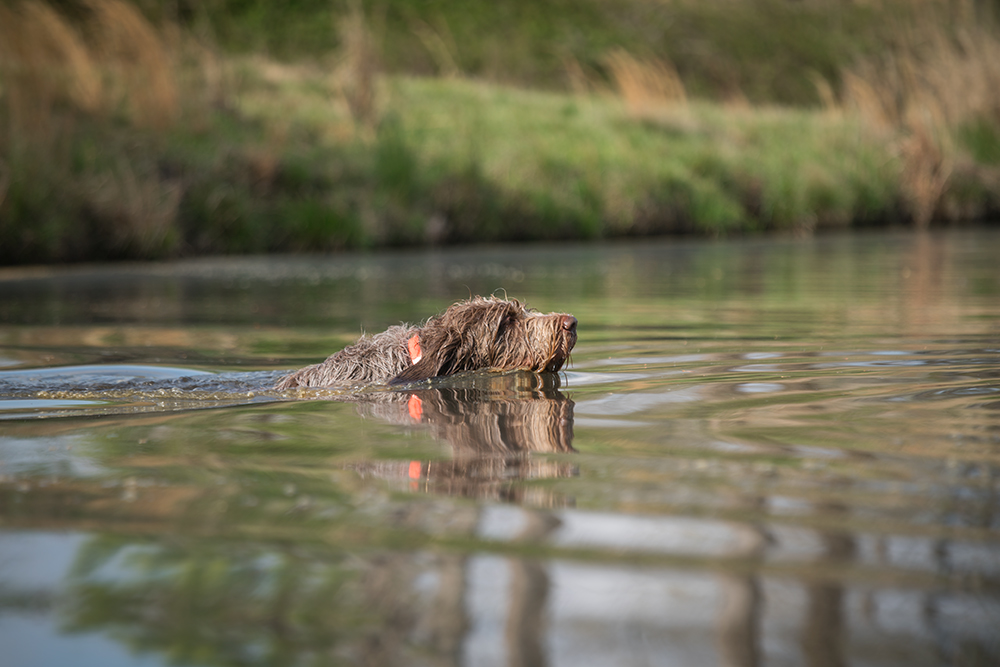
Carolyn says, “Ludo was a natural swimmer, retriever, and a staunch pointer on pheasant and partridge. He showed great potential, so I offered him to trainer Rory Majors, who had seen the Bedeslea Spinoni hunt and trial since the kennel was formed in 1987. He had been impressed with Callisto’s natural ground coverage and intelligent style as well.”
Over three seasons, Rory and Ludo received seven awards, including the title of Top Field Trial Spinone in both 2010 and 2011. At age seven, after recovering from a torn anterior cruciate ligament (ACL), Ludo was sent to Easton, Pennsylvania, to spend his retirement years with Karen and her partner Ann Bagnell. They had bred one of their dogs to Ludo and welcomed the opportunity to keep him here because of his pedigree and value to the small US Spinone gene pool.
When they brought him to Vermont during grouse season, Ludo was eager to show us exactly what had earned him those UK titles and why “retirement” wasn’t in his vocabulary yet.
“As a hunting dog, Ludo combines tenacity and independence with a real desire to please and a cooperative nature,” Ann explains. “It’s in the thick cover or bog that he comes into his own. He is a methodical hunter, quite capable of running large in big fields, but in the presence of scent he slows down and works carefully, using that big Spinone nose to its best advantage. He will never run over his nose or push a bird needlessly, and he can also have a pronounced catwalk in the presence of game—caution that produces a point in range of the gun.”
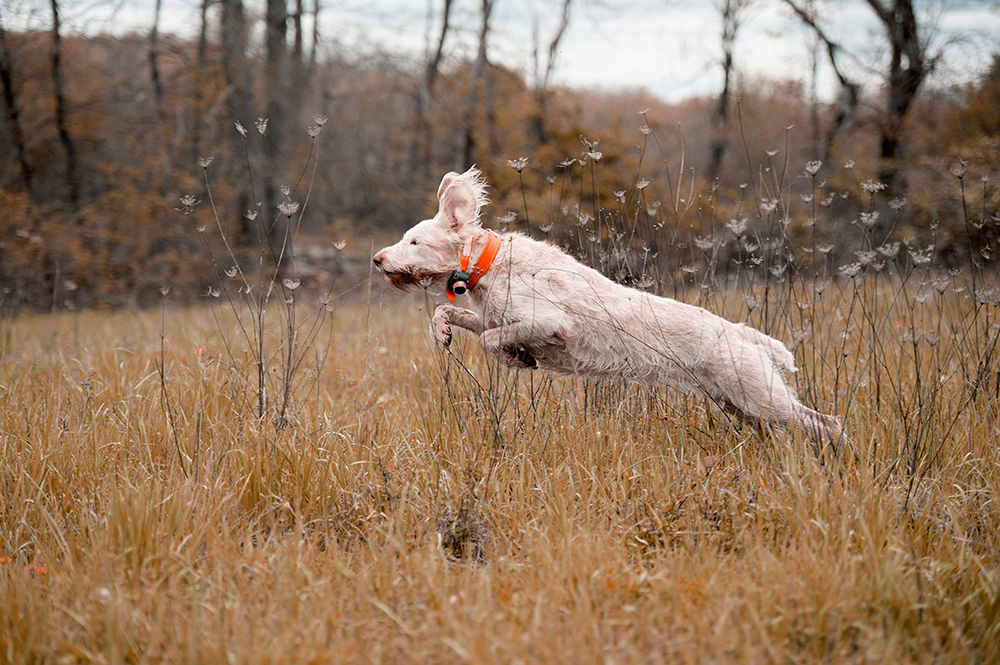
When they brought him to Vermont during grouse season, Ludo was eager to show us exactly what had earned him those UK titles and why “retirement” wasn’t in his vocabulary yet.
Back at the house eating lunch, I had the other side of Spinone magic delivered to me in the form of Ludo’s head—roughly the weight of a bowling ball—plopped on my lap. His eyes gazed out with some sort of fundamental perpetual happiness, and he was quite willing to let me twirl the long locks of his beard around my fingers.
Ann says one key trait of the Spinone breed relates to their heart and soul. “They have a sweet, human-like expression. Because their eyes are placed on the frontal plane, set well apart, wide and open in their gaze, they look at us as another human would. To me, this reflects the natural sweetness and desire to work with us as our partner in all things.”
“As an example, I was once crossing a shallow stream with our first Spinone, Luchi,” Ann continues. “I was wearing rubber boots and crossing on slippery rocks, so I walked gingerly and slowly. Luchi took one look at me, and although with her big, catlike paws she could have bounded across the rocks, she seemed to figure that this is what we were doing together, and proceeded to slowly and carefully step across the stones as I did.”
Karen’s Brasch was a similar partner. “A Versatile Champion and Master Hunter, both at age two, Brasch was an ‘out-of-the-box’ dog who was a natural hunter in all environments. He was the dog we called on when other dogs couldn’t find the duck. He would leave the shore with no cues or clues, be gone as long as needed, and come back perhaps covered in mud, but always with the duck. His persistence could be considered stubbornness, but when channeled, it is a wonderful trait in a hunting companion,” says Karen.
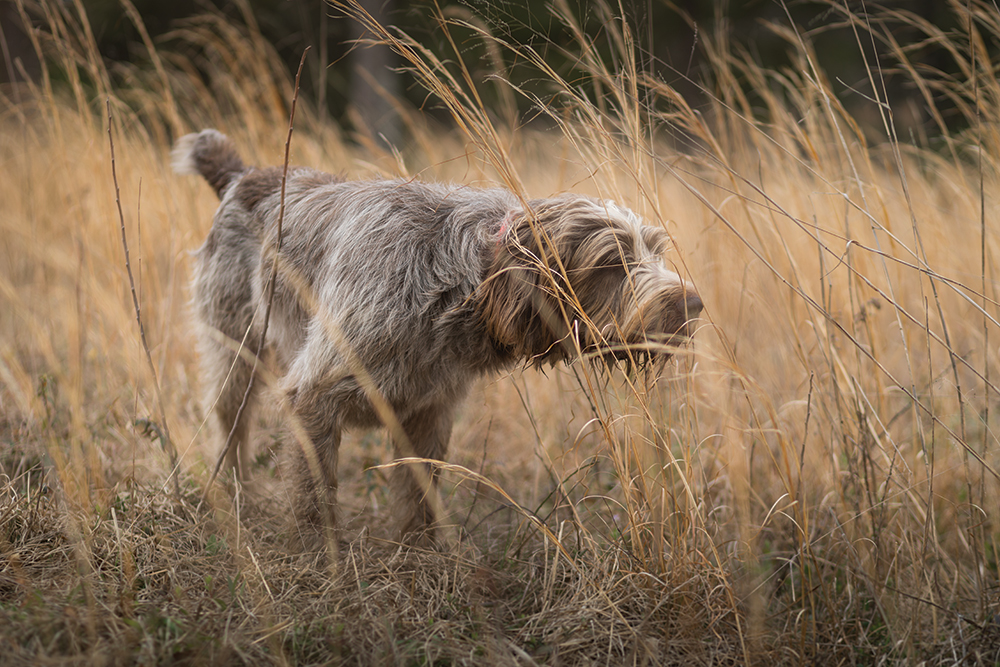
Spinoni come in a variety of colors: pure white, white with orange, white with brown, orange roan, and brown roan. Their coats should be flat but wired, without an undercoat. The coat’s roughness and the thick, leathery skin are two of the hallmarks of the breed; the name “Spinone” comes from Bracco Spinoso, which means prickly pointer, referring to the harshness of the coat as well as its ability to withstand thorns and bristly brush.
Spinoni are large, robust dogs with a tendency towards mischievousness when bored. They are thinkers, and training Spinoni can be complex because of this. If something doesn’t make sense to them, they resist taking direction. Trainers need to “read” Spinoni carefully, working not just with pressure but with a consistent hand and positive reinforcement.
Both Karen and Ann are North American Versatile Hunting Dog Association judges, giving them a lot of opportunities to observe other breeds and many individual dogs. “We are seeing the picture of hunting Spinoni in this country change as more breeders work hard to breed to type, as well as to work the dogs they breed to be sure we keep the hunting traits in the lines,” says Ann. “As grouse and woodcock hunters primarily, and sometimes waterfowlers, the Spinone style of air scenting, ground tracking, and stealthily pointing the way for the gun is ideal for the cover we hunt and reflects the conditions for which they were originally bred.”
























